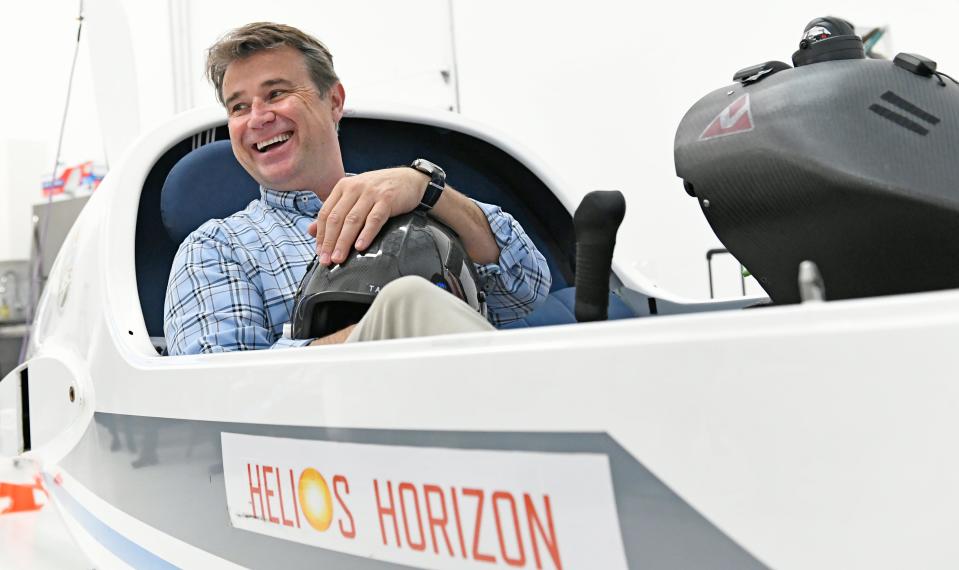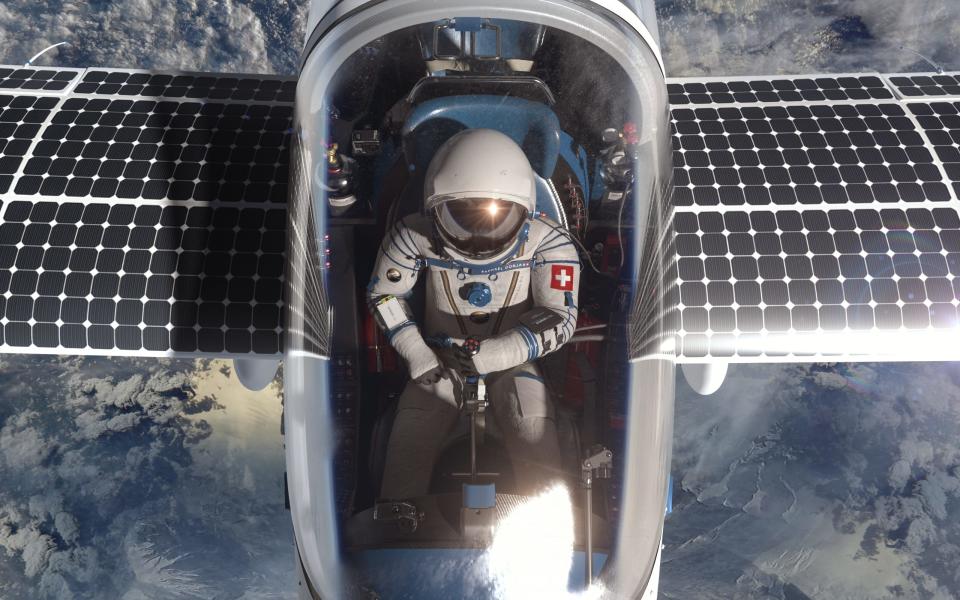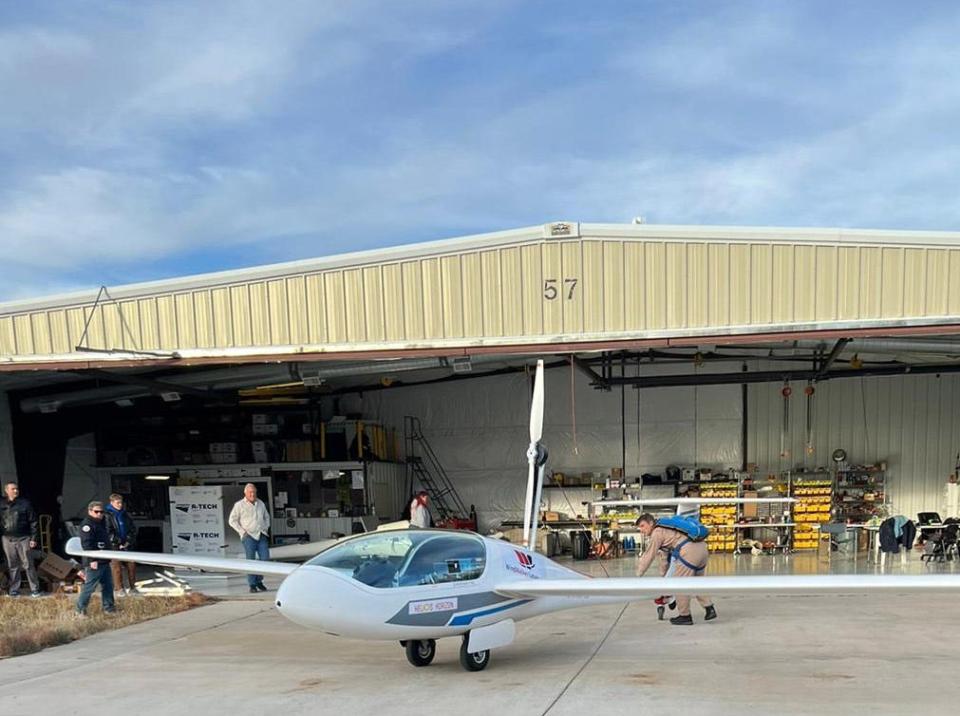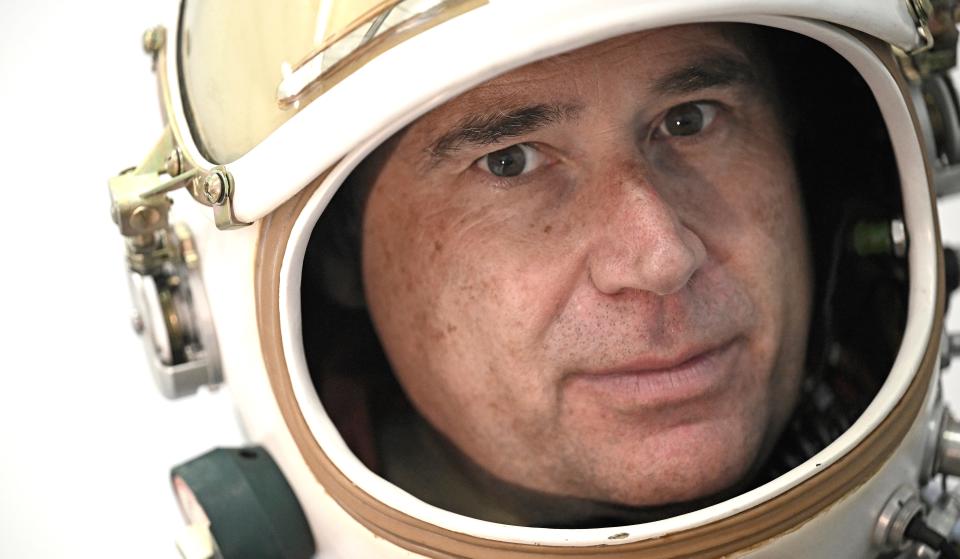Sarasota test pilot hopes to set electric flight altitude record this May in Nevada
Miguel Iturmendi, a Sarasota test pilot and engineer who already holds world records for the fastest and highest-flying glider, has four goals for his current aircraft, the electric-powered Helios Horizon.
Phase one – which Iturmendi hopes to accomplish next month in Minden, Nevada, near Lake Tahoe – is to get the absolute world record of 32,000 feet for an electric-powered flight, which is currently held by the Solar Impulse, a $260 million Swiss project that he flew for that record in April 2021.

Related: The Right Stuff: Sarasota test pilot pushing the envelope of solar flight
Iturmendi told a crowd gathered in March for a combined fundraiser/showcase event that he hoped to capture that record.
Solar Impulse actually has two world records, one set by Iturmendi in horizontal flight and one set by Bertran Piccard in altitude gain.

Iturmendi will fly a battery powered version of the carbon-fiber framed Helios Horizon, which will feature a propeller with blades 39 inches long mounted to the aircraft at the end of a 40-inch tall mast.
The 50 kilowatt, liquid-cooled electric motor generates about 60 horsepower.
While climbing, the plane can fly at 60 mph. Once at altitude it has a top speed of 85 mph.
Phase two will be to take that aircraft to 43,000 feet and be the first-ever electric aircraft to go into the stratosphere.
That flight and the Phase three fight will also launch from Minden, Nevada.
For Phase three in 2025, the Helios Horizon will be equipped with wings that can capture solar energy to power the engine and to again fly into the stratosphere using solar power.
For Phase four, Iturmendi, envisions a victory tour, “Which is to go and fly above peaks around the world – Everest and Denali – and do a nice video to promote electric aviation,” he said.
A history of pioneering flights
Iturmendi, 51, piloted the Helios Horizon to the U.S. altitude record for a manned electric aircraft under 500 kg on Nov. 5, 2022 in Moriarty, New Mexico.

Much of his recent test pilot experience has come via either high-altitude gliders or electric aircraft.
He has served for more than a decade on the engineering team and as an experimental test pilot for the Perlan Project, a record-setting stratospheric glider, for more than three years as lead test pilot for the solar electric powered Solar Stratos and lead experimental test pilot for Skydweller Aero’s Solar Impulse 2.
In 2016, the Solar Impulse became the first solar powered plane to circumnavigate the world.

A native of Spain, Iturmendi earned the Living Legend of Aviation Award in 2019 for flying at a then-record 66,000 feet as test pilot of the Perlan 2 glider.
His fellow glider teammate and lead pilot Jim Payne also earned the award as part of those test flights.
In August 2020, he piloted the SolarStratos solar powered aircraft when Swiss adventurer Raphael Domjan jumped from the aircraft to perform the first ever jump from a solar electric powered aircraft above the air base in Payerne, Switzerland,
The purpose of all these flights – as well as Iturmendi’s own goal for Helios Horizon – is a combination of proof of concept and to provide a spark for electric-powered aviation as an alternative to conventional aircraft ,and in turn reduce the amount of carbon dioxide produced by air travel.
While long-range passenger flight will likely be the domain of traditional aircraft, Iturmendi pointed to the January 2023 accomplishment of ZeroAvia, in which a 19-seat twin-engine aircraft used one electric engine powered by a hydrogen fuel cell as part of the HyFlyer II project.
That project, backed in part by the United Kingdom’s Aerospace Technology Institute, has a goal of developing 19-seat hydrogen powered electric aircraft with a 300-mile radius by 2025, and 40- to 80-seat aircraft with a 700 mile range by 2027.
Iturmendi sees the Helios Horizon flight as another key step in the advancement of electric-powered aviation.
“This is a proof of concept to show that an electric aircraft can fly higher than a jet aircraft, without polluting the atmosphere, but the case for how that can be commercialized, I’m not getting into that,” Iturmendi said. “None of this is for profit; this is for science and engineering.”
Success may bring investors
Still, the hope is that new altitude records in May will prompt additional investors, which would allow for additional development and some compensation for the volunteer engineers and the effort to fly into the stratosphere.
“That’s a little more expensive,” Iturmendi said.
Mike Willeford, owner of Windwalker Labels, a Wisconsin-based printing company who also has a home in Lakewood Ranch, met Iturmendi through Javier Merino, the Helios Horizon project manager.
A pilot himself, Willeford said his love of aviation led him to become an early project investor.
“I love aviation, I love cutting edge technology – especially when it’s environmentally friendly, and I just think something like this could be a big step in moving from one type of aviation to another,” Willeford said.
Traditional combustion engines require air to operate. Electric motors do not.
The electric motor of the Helios Horizon can run virtually stress free, as long as it has consistent power.
“It’s like a fan in your house,” Iturmendi said.
Currently Iturmendi said, about $400,000 has been spent on Helios Horizon. That’s pocket change compared to the money pumped into other electric aviation test projects.
The half-dozen or so scientists and engineers dedicated to the project are all volunteers, as are Iturmendi and Merino.
Iturmendi decided to go out on his own because he has a differing philosophy.
All of the components of the Helios Horizon – from the airframe to the engine and the propeller – already exist.
They were chosen by Iturmendi because their tolerances exceed those required to achieve the aircraft’s height and speed goals.
That’s a divergence from existing electric aircraft.
“Everybody else was taking a model that was 50 kilowatts and running it at 48 kilowatts, so the model was getting too hot,” Iturmendi said.
Since heat does not easily dissipate at high altitude, that was limiting the performance of previous electrically powered aircraft.
The Helios Horizon should run cooler because the motor isn’t under as much stress.
The chosen airframe for the aircraft – which weighs in at 575 pounds – can carry a payload of close to 1,600 pounds tested to 9 G’s, which is significantly more than the test flight requires.
Iturmendi noted that his approach is now mirrored by another company, but Helios Horizon is roughly a year-and-a-half ahead in the process.
Flying cars vs. electric planes
Iturmenda estimates that there are about 30 electric airplanes in the world – all of them custom made.
Meanwhile, he said there are more than 1,000 electric aviation research projects concentrating on vertical take off and landing – “which is the flying car, flying Uber.”
Helios Horizon is part of that high-altitude research that can one day lead to passenger aircraft, which produce 4% of all emissions worldwide, or even cargo aircraft.
“This is in its infancy for aviation; this is where electric cars were 20 years ago,” Iturmendi said. “There were electric cars 20 years ago but they couldn’t do much.
“That’s the same thing for aviation, " he said, then added, “If you go from here to Miami on a regional flight, why wouldn’t you be able to fly on an electric motor?”
This article originally appeared on Sarasota Herald-Tribune: Sarasota's iturmendi hopes Helios Horizon soars to the stratosphere

